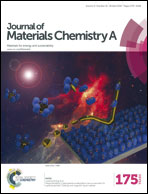Growth of vertically aligned MoS2 nanosheets on a Ti substrate through a self-supported bonding interface for high-performance lithium-ion batteries: a general approach†
Abstract
A promising new concept is to apply additive/binder-free electrodes for lithium-ion batteries by directly growing active materials on current collectors, however, they still suffer from the low quality electronic contact and poor mechanical stability due to the lattice mismatch between active materials and substrates. Here we present the direct growth of vertically aligned MoS2 nanosheets on a Ti substrate through a self-supported TiO2 bonding interface route, thereby preferentially exposing the edges on the film surface. In this unique structure, MoS2 nanosheets are interconnected with each other and create a strong adhesion to the Ti substrate through the TiO2 bonding interface, which would allow electrons to easily transport throughout the whole electrode. Furthermore, their edge-terminated structure can provide more sites for Li-ion intercalation. By using this additive/binder-free electrode, it can deliver a discharge capacity as high as 1189 mA h g−1 at a current density of 1000 mA g−1 after 600 cycles. Importantly, our synthetic approach, based on this metal surface dissolution–crystallization produced bonding interface, can provide a general strategy for the direct growth of other metal sulphides such as NiS and CoS nanosheets on the Ti substrate with great promise for various applications.

- This article is part of the themed collection: 2016 Journal of Materials Chemistry A HOT Papers

 Please wait while we load your content...
Please wait while we load your content...